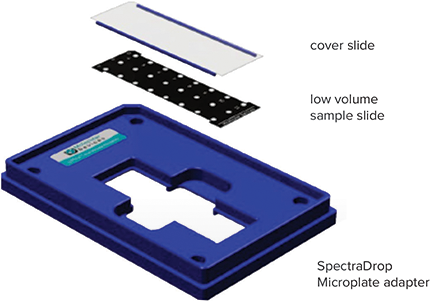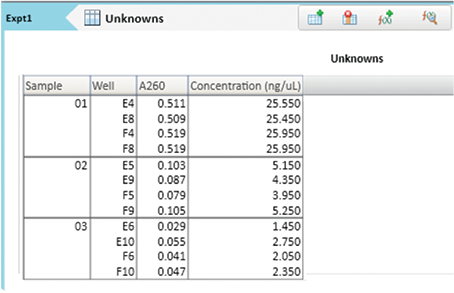
Application Note
Maximizing performance of the SpectraDrop Micro-Volume Microplate for DNA quantitation
- Quantitate DNA down to at least 2 ng/uL
- Save precious sample by using 2- or 4-uL samples
- Measure up to 64 samples in a single plate
Introduction
Molecular Devices SpectraDrop™Micro-Volume Microplate allows users to read up to 64 samples per plate on SpectraMax®Microplate Readers, with sample volumes as low as 2 µL. The SpectraDrop Microplate incorporates a specially designed adapter and a slide pair whose optical clarity allows measurements in absorbance and fluorescence modes to meet users’ application needs (Figure 1). The SpectraDrop Microplate’s slide design eliminates the need for calibration and gives consistent well-to-well reads with CVs below 5%.

Figure 1. SpectraDrop Micro-Volume Microplate configuration.
The low-volume sample slide has a mask delineating spots or ‘wells’ that hold 24 or 64 samples. The cover slide has 0.5-mm or 1.0-mm spacers for use with 2-µL or 4-µL samples, respectively.
The SpectraDrop Microplate kit consists of the following components:
- SBS-standard microplate adapter
- 24-well low volume sample slide or 64- well low volume sample slide
- 0.5 mm path length (clear spacers) cover slide for 2-µl samples
- 1.0 mm path length (blue spacers) cover slide for 4-µl samples
Measurement of nucleic acids using UV absorbance is a common method allowing quantitation of many sample types. A key consideration for optimal performance of these measurements is reduction of background noise that can result from the presence of contaminants in samples and on optical surfaces. This application note describes how to maximize performance through simple, routine care and cleaning.
Materials
- SpectraDropMicro-Volume Microplate
- Lint-free or low-lint disposable lab wipes
- Air duster (can of compressed air)
- Double-stranded DNA (e.g., Sigma P/N D1501-1G)
- Deionized water or TE buffer
- 8-channel pipettor capable of pipetting 2 or 4 µL
- SpectraMax Microplate Reader with absorbance detection mode
Methods
Cleaning the SpectraDrop slides
Handle the SpectraDrop slides by their edges, and examine them against a dark background to identify any smudges or dust. Wearing powder-free latex or nitrile lab gloves will help to minimize fingerprints and smudging with skin oils. If smudges or dust are observed, use a disposable lab wipe to clean the slides. Remove resistant smudges or fingerprints using a water- or alcohol-dampened lab wipe. Trace-free swabs may be used in lieu of lab wipes.
For most sample measurements, simply wiping the slides with disposable lab wipes is sufficient. If sample concentrations are predicted to be low, or minimal background noise is desired, the following steps will be important. Re-examine the slides against a dark background to ensure they are free of dust particles. Remove any visible dust particles using a canned air duster to minimize background noise. Use the air duster in short, gentle bursts to blow off any dust adhering to the slides. Longer or more forceful bursts will lead to overcooling and condensation on the slides that may not be easily removed. Anti-static spray is not recommended for use with the SpectraDrop slides.
Buffers or other solutions used in measurements with the SpectraDrop Microplate can be filtered to minimize particulates that may cause elevated background values and sample-to-sample variability.
Note: Strong acids or alkali solvents should not be used with the SpectraDropMicroVolume Microplate because they will damage the slide mask.
Results
DNA standard curve
To demonstrate sensitivity of DNA detection with the SpectraDrop MicroVolume Microplate, DNA standards of known concentrations ranging from 1.9 to 190 ng/µL were prepared in TE buffer and pipetted onto the wells (spots) of the SpectraDrop Micro-Volume Microplate, along with TE buffer blanks, in sets of three or six replicates using an 8-channel pipettor. Volume per spot was 2 µL using the SpectraDrop top slide with 0.5-mm spacers.
The SpectraDrop Plate was read on a SpectraMax M5eMicroplate Reader, and data were analyzed and graphed with SoftMax®Pro Software (Figure 2). The lower limit of detection for doublestranded DNA based on a calculation of three times standard deviation of the background was less than 2 ng/µL when slides were cleaned using the guidelines above.

Figure 2. DNA standard curve.
DNA standard curve on SpectraDropMicro-Volume Microplate, read on a SpectraMax® M-series microplate reader. Sample slides with up to 64 wells allow users to run entire standard curves or large sample sets on a single slide
DNA quantitation
DNA concentration may be calculated directly from absorbance readings at 260 nm using the Beer-Lambert law, A=x ξ c, where A is absorbance at 260 nm, ξ is molar absorptivity, l is the length of solution through which the light passes, and c is the concentration of the solution. For double-stranded DNA dissolved in TE buffer, the concentration factor (reciprocal of molar absorptivity) is 45. The pathlength (l) for the SpectraDrop Micro-Volume Microplate is either 0.5 mm or 1.0 mm, depending on which cover slide option is used.
For SoftMax Pro software, preconfigured protocols are available to simplify the calculation of DNA concentrations for samples read using the SpectraDrop Micro-Volume Microplate. Pathlengths corresponding to the slide spacers used are applied to automatically calculate sample concentrations directly from absorbance measurements (Figure 3).

Figure 3. SoftMax Pro Software group table.
Group table from SoftMax Pro Software DNA quantitation protocol for SpectraDrop Micro-Volume Microplate. Using the pathlength value for a 0.5-mm spacer slide, and concentration factor specific for double-stranded DNA in TE buffer, concentrations were calculated automatically by the software..
Conclusion
A key factor in maximizing performance of the SpectraDropMicro-Volume Microplate is proper cleaning. Eliminating dust particles and smudges on the SpectraDrop Microplate’s slides minimizes background absorbance and sample-to-sample variability to give optimal sensitivity and reliability of results. It is possible to exceed the sensitivity specification of 2 ng/µL when slides are cleaned carefully as described above. For many users who are measuring samples well above 2 ng/µL, simply wiping the SpectraDrop slides clean with lint-free or low-lint lab wipes is sufficient.
The SpectraDrop Micro-Volume Microplate enables sensitive measurement of small sample volumes without compromising accuracy. The SpectraDrop Microplate’s slides are easy to handle, and all optical surfaces are fully accessible for ease of cleaning. No well-to-well calibration is required, as the spacer and slide design provide excellent well-to-well uniformity. 24- and 64-well sample slides, as well as cover slides with 0.5- or 1.0-mm spacers, are available to meet users’ throughput and sample volume needs. The SpectraDrop Micro-Volume Microplate is compatible with all SpectraMax Readers including the SpectraMax Paradigm®Platform, as well as the StakMax®Microplate Stacker.
Learn more >>
引言
Molecular Devices公司的SpectraDrop™ 超微量微孔板(原先称为µMax)让用户在 SpectraMax®微孔板读板机上可一次检 测多达64个样品,而上样体积仅2 µL。 SpectraDrop微孔板带有一套专门设计 的适配器和玻片,此玻片在光吸收和荧光 检测下的光学透性完全满足用户对应用的 苛刻要求(图1)。SpectraDrop微孔板的 特殊玻片设计无需校正,可保持孔间测读 的一致性,孔间CV低于5%。

***超微量样品载玻片上有专门的小孔用于24或64个样品上样。*盖玻片有0.5-mm或1.0-mm两种间 隔可选,分别用于2-µL或4-µL上样量。
SpectraDrop微孔板套装包含以下部分:
- SBS-标准微孔板适配器
- 24-孔超微量样品载玻片或64-孔超微 量样品载玻片
- 0.5 mm光程(透明)盖玻片,针对2-µl上 样体积
- 1.0 mm光程(蓝色)盖玻片,针对4-µl上 样体积
使用紫外光吸收来定量检测多种样品类型 是一种常用的方法。获得更优检测结果的 一个决定性因素就是降低样品或光学表面 污染所产生的背景噪音。这篇应用文章描 述了如何通过简单、常规的维护和清洁步 骤即可得到高质量的结果。
材料
- SpectraDrop超微量微孔板
- 无绒或低绒一次性吸水纸
- 空气除尘器(罐装压缩空气)
- 70%乙醇溶液(或其它有机溶剂如甲醇或丙酮)
- 双链DNA(如Sigma P/N D1501-1G)
- 去离子水或TE缓冲液
- 可移取2或4 µL的8-通道移液器
- SpectraMax® 微孔板读板机,带光吸收检测功能
方法
清洁SpectraDrop玻片
捏住SpectraDrop玻片边缘将其拿起, 在黑色背景下检查上面是否粘有污渍或灰 尘。戴无粉乳胶手套有助于减少指印和皮 肤油脂的污染。如果发现有污渍或灰尘, 可使用一次性实验室用纸清洁玻片。要去 掉顽固的污渍或指印,需要用到沾了水或 乙醇的实验室用纸来清洁。不会留下擦拭 痕迹的抹布等也可代替实验室用纸。
对于大多数的样品检测,用一次性实验室 用纸简单的擦拭玻片就足够了。如果预计 样品浓度太低或希望降低背景噪音,以下 步骤会很重要。重新在黑色背景下检查玻 片,确保没有灰尘微粒。使用带空气罐的 除尘器将任何可见的灰尘颗粒清除以降低 背景噪音。使用空气除尘器短暂、轻柔的 吹气将任何粘附在玻片上的灰尘吹走。长 时间或太用力的吹气会导致玻片过冷并产 生冷凝作用,可能会更加难以清洁。防静 电喷雾并不建议用在SpectraDrop玻片 上。
缓冲液或其它用于SpectraDrop微孔板 检测的溶液可以被过滤以减少溶液中的微 粒,这些微粒可能会增加背景值和不同样 品间的差异。
注 意 : 强酸或强碱溶剂不可用 于 SpectraDrop超微量微孔板,因为会损 坏玻片上的上样孔。
结果
DNA标准曲线
为了确定SpectraDrop超微量微孔板的 DNA检测灵敏度,将溶于TE缓冲液的浓 度范围为1.9到190 ng/µL的DNA标准品加 入到SpectraDrop超微量微孔板的上样 孔中,TE缓冲液作为空白,使用8通道移 液器做3或6个重复。利用SpectraDrop 0.5-mm间隔的盖玻片,每孔的样品体积 为2 µL。
SpectraDrop超微量板在SpectraMax M5e微孔板读板机上进行测读 , SoftMax® Pro 6软件分析数据并绘制曲 线(图2)。基于背景的3次标准偏差计算的 双链DNA检测限低于2 ng/µL,只需用上 述指南对玻片清洁。

在SpectraMax® M系列微孔板读板机上使用SpectraDrop超微量微孔板得到的DNA标准曲线
D多达64孔的样品玻片让用户在一块玻片上即可完成全部标准曲线测定或更多的样品检测。
DNA定量
DNA浓度可以通过检测260 nm光吸收直接计算出来,使用的是朗伯比尔定律, A=lc,A为260 nm光吸收值, 为摩尔吸光度,l为光程,c为溶液浓度。对于 溶 于 T E缓冲液的双 链 DNA,其浓度因子(摩尔吸光度的倒数)为45 。 SpectraDrop超微量微孔板的光程可以是0.5 mm或1.0 mm,这取决于所选用的 盖玻片。
在SoftMax® Pro 6软件中,有专门简化SpectraDrop超微量微孔板进行DNA样 品浓度检测和计算的预设模板。光吸收值和玻片间隔所对应的光程可以直接自动 计算出样品浓度(图3)。

数据表格来自于SoftMax Pro软件的SpectraDrop超微量DNA定量模板。
使用的是光程为0.5-mm 间隔的玻片,浓度因子针对溶于TE缓冲液的双链DNA,通过软件自动计算出浓度。
总结
要发挥SpectraDrop超微量微孔板方法性 能的一个关键因素就是足够清洁。清除玻 片上的灰尘微粒和污渍可以减小背景光吸 收和样品之间的差异,从而给出更好的灵 敏度和可靠的结果。如果可以像上述介绍 的方法一样仔细清洁玻片,那么是能够得 到比2 ng/µL的参数更好的灵敏度的。对于 许多高于2 ng/µL灵敏度要求的用户样品 检测,只需简单的用无绒或低绒实验室用 纸擦拭清洁SpectraDrop玻片便足够了。
SpectraDrop超微量微孔板可以实现少 量样品的灵敏检测而不会牺牲准确性。 SpectraDrop超微量微孔板易于操作, 并且所有光学表面都非常易于清洁。无需 孔间校准,因为间隔式玻片设计具有完美 的孔间一致性。24-和64-孔样品玻片以 及0.5-或1.0-mm间隔的盖玻片完全满 足用户的通量和样品体积要求 。 SpectraDrop超微量微孔板兼容所有 SpectraMax读板机包括SpectraMax Paradigm®平台以及StakMax®微孔板堆 板机。
Learn more >>